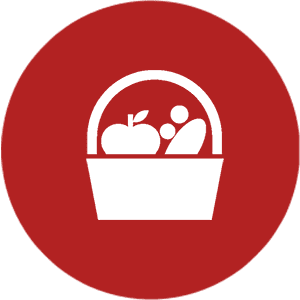
Strive for every member of our community to have a food secure future. No one in Lewiston-Auburn should go hungry.
Food security means having access at all times to sufficient, safe, nutritious food to maintain a healthy and active life (WHO 2016). In other words, it’s about knowing where and when your next meal will come from, and not worrying about going hungry. A community with high food security supports children that are able to learn and play, which results in numerous positive health and economic multiplier effects.
Unfortunately, we know that not everyone in L-A is food secure. For example, in the Lewiston school district, 71.5% of all students in 2015 were eligible for free/reduced meals at school; that percentage rose to 100% at the Longley Elementary School located downtown.

Consider local and sustainable agriculture when making food decisions for ourselves and our families. Production systems should enhance healthy soil and clean water; similarly, economic systems should return a fair wage to labor and a fair income to farmers.
Sustainable agriculture refers to a farming system that is capable of maintaining its productivity and usefulness to society indefinitely, and leaves the natural world as healthy or better than it was found. In general, sustainable agriculture addresses the ecological, economic and social aspects of agriculture. “To be sustainable, agriculture can operate only when the environment, its caretakers and surrounding communities are healthy.” (Leopold Center for Sustainable Agriculture). Benefits of sustainable agriculture include more nutritious food, clean water, clean air, and healthy soil. Many industrial farm operations do not use sustainable practices, which can cause great damage to the environment – additionally, as soil quality diminishes, the nutrient quality of food is also reduced.
Although locally-grown does not necessarily equate to sustainable practices, food produced locally does not travel the (average) 1500 miles from farm to fork. In general, food produced in Maine is usually from a small or medium-sized operation, has used up less petrochemicals to get your plate, and returns a better wage to farm workers than larger industrial operations elsewhere in the world.

Enable leadership by all members of our community by sharing knowledge of good food and related resources and empowering individuals to take action.
If you eat food, there is a food system leadership role for you to play. To reach the goal of good food for all of L-A, there are many decisions and action steps – both small and large – to be made across our community. We will need individuals to show leadership – by understanding the complex, diverse nature of our local food system and championing needed change – and for organizations to lead change as well.
Leadership can show up in numerous ways: an employer who offers payroll deductions for Community Supported Agriculture (CSA) shares; a parent who volunteers at a school garden; an elder care facility that partners with farmers to offer a local, seasonal produce to residents; a fresh food business owner who welcomes SNAP/EBT customers; a policymaker who champions public transportation which in turn increases access to good food sources; a regular patron of the Lewiston or Auburn Farmers’ Market; an institution that makes a commitment to source a certain percentage of food from Maine or regionally and encourages their peers to do the same; a community member who teaches an adult-education cooking class; a student who encourages peers to choose healthy lunch options; a community member who engages in an event related to the Food Charter – there are infinite examples, and they are all important.

Elevating good food policy by engaging and informing our local officials and leaders, lifting up examples of what works in other places, and using the definition of good food to evaluate relevant legislation and policy decisions.
A food policy is any decision, program or project that is endorsed by a government agency, business, or organization which affects how food is produced, processed, distributed, purchased, protected and disposed (Vancouver Food Policy Council 2016). There are many food policy success stories from across the country, at all levels of government and at organizations big and small. Finding policy solutions to address local issues first requires a willingness to consider food system and food security issues as fundamental to public health, community resilience, and a strong economy. Looking at other communities as case studies, research can be done to find policy solutions that match our community’s needs, characteristics, assets, and energies. Business and organizational leaders, elected officials and city staff have unique leadership roles to play, but any member of the community should also feel empowered to educate local leaders and advocate for good food policies they would like to see implemented in L-A.

Support the preservation of working landscapes and development of community infrastructure that enhances production of and access to good food.
Working landscapes refer to land and water actively used in productive agriculture, forestry or fisheries, often privately owned. Without local working landscapes, there is no local food. Preservation and use of working landscapes within the greater Lewiston-Auburn area is necessary for the continued growth of local food production and related enterprises, as well as many cultural, economic, environmental, recreational and quality of life benefits.
Community infrastructure refers to all the components that agricultural producers, food entrepreneurs and businesses/institutions need for reliable pathways for bringing local products to market and to the consumer. This includes seed, feed and compost suppliers; equipment repair and fabrication services; food processors, distributors, and retail outlets; logistics managers, waste handlers, and surplus food rescue (MSU 2010). Some examples of community infrastructure are: appropriate washing, chopping, and packaging facilities, meat processing facilities, trucks for distribution, and cold/dry storage facilities. A lack of community infrastructure creates a barrier for the average person to consume more local food – at home, schools, hospitals, nursing homes, and area restaurants.
Preservation and productive use of working landscapes and incremental investments in community infrastructure, paired with investments in education and training in local food preparation, can help to increase the average community member’s access to local food.
As the L-A Community Food Charter movement continues to grow, this page will sprout more educational resources and statistics!
Bibliography
- Alkon, Alison Hope and Agyeman, Julian. Cultivating Food Justice. Cambridge, MA: The MIT Press, 2011.
- Good Food Council of Lewiston-Auburn. Community Food Assessment, Lewiston ME. 2013
- Leopold Center for Sustainable Agriculture, Iowa State University.
- Maine Department of Education, 2015
- MSU. Food System Infrastructure: Michigan Good Food Work Group Report Series. Michigan Good Food, Michigan State University, C.S. Mott Group for Sustainable Food Systems at Michigan State University, 2010.
- United States Congress. “Food, Agriculture, Conservation, and Trade Act of 1990.” Public Law 101-624, Title XVI, Subtitle A, Section 1603. Washington, D.C.: Government Printing Office, 1990.
- Vancouver Food Policy Council. “What is food policy?” 2016. http://www.vancouverfoodpolicycouncil.ca/what-is-food-policy/ (accessed Mar 12, 2016).
- WHO. “Trade, foreign policy, diplomacy and health: Food Security.” World Health Organization. 2016. http://www.who.int/trade/glossary/story028/en/ (accessed Mar 16, 2016).